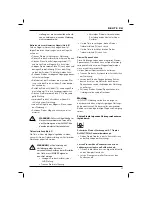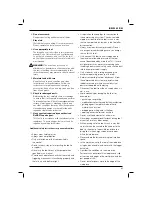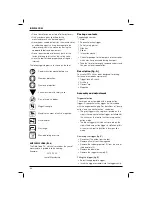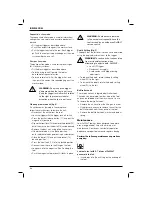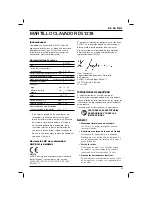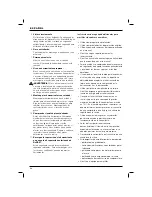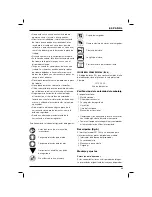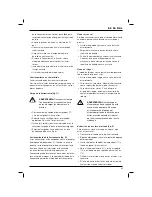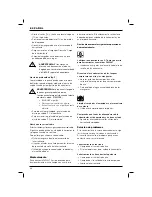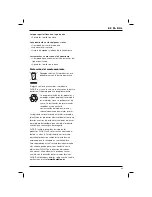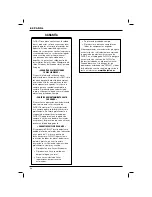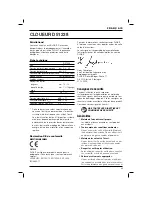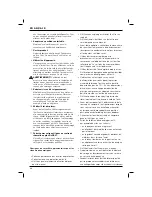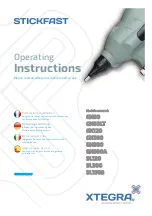
21
E N G L I S H
6.
Do not overreach.
Keep proper footing and balance at all times.
7.
Stay alert.
Watch what you are doing. Use common sense.
Do not operate the tool when you are tired.
8.
Use appropriate tool.
The intended use is described in this instruction
manual. Do not force small tools or attachments
to do the job of a heavy-duty tool. The tool will
do the job better and safer at the rate for which it
was intended.
WARNING!
The use of any accessory or
attachment or performance of any operation with
this tool, other than those recommended in this
instruction manual, may present a risk of personal
injury.
9.
Maintain tools with care.
Keep the tools in good condition and clean
for better and safer performance. Follow the
instructions for maintenance and changing
accessories. Keep all controls dry, clean and free
from oil and grease.
10.
Check for damaged parts.
Before using the tool, carefully check it for damage
to ensure that it will operate properly and perform
its intended function. Check for misalignment and
seizure of moving parts, breakage of parts and
any other conditions that may affect its operation.
Have damaged guards or other defective parts
repaired or replaced as instructed.
11.
Have your tool repaired by an authorised
D
E
WALT repair agent.
This tool is in accordance with the relevant safety
regulations. To avoid danger, tools must only be
repaired by qualified technicians.
Additional safety instructions for pneumatic nailers
• Always wear safety glasses.
• Always wear ear protection.
• Only use fasteners of the type specifi ed in
the manual.
• Do not use any stands for mounting the tool to
a support.
• Never use the tool for any other purpose than
specifi ed in this manual.
• Prior to each operation check that the safety and
triggering mechanism is functioning properly and
that all nuts and bolts are tight.
• Use quick-action couplings for connection to
the compressed air system. The non-sealable
nipple must be fi tted to the tool in such a way
that no compressed air remains in the tool after
disconnection.
• Always use clean, dry compressed air. Do not
use oxygen or combustible gases as an energy
source for this tool.
• Only connect this tool to an air supply where
the maximum allowable pressure of the tool
cannot be exceeded by more than 10%. In case
of higher pressures, a pressure reducing valve
including a downstream safety valve shall be built
into the compressed air supply.
• Only use hoses with a rating exceeding the
maximum operating pressure of the tool.
• Before transporting the tool, disconnect it from
the compressed air system, especially where
ladders are used or where unusual physical
posture is adopted while moving.
• Disconnect the tool from the air supply when it is
not in use.
• Avoid weakening or damaging the tool, for
example by:
– punching or engraving
– modifi cations not authorised by the manufacturer
– guiding against templates made of hard
material such as steel
– dropping or pushing across the fl oor
– applying excessive force of any kind
• Do not use the equipment as a hammer.
• Never point any operational fastener driving tool
at yourself or at any other person.
• While working, hold the tool in such a way that
no injuries can be caused to the head or to the
body in the event of a possible recoil due to a
disruption in the energy supply or hard areas
within the workpiece.
• Never actuate the fastener driving tool into free
space.
• In the work area, carry the tool at the workplace
using only one handle, and never with the trigger
actuated.
• Consider the conditions in the work area.
Fasteners can penetrate thin workpieces or slip
off corners and edges of the workpiece, and thus
put people at risk.
• Do not drive fasteners close to the edge of the
workpiece.
Содержание D51238
Страница 1: ...1 D51238 www eu ...
Страница 3: ...3 B 4 3 1 2 16 A C 5 6 8 7 3 4 11 ...
Страница 4: ...4 F D E 1 G ...
Страница 105: ...105 ...
Страница 106: ...106 ...
Страница 107: ...107 ...











